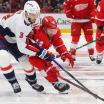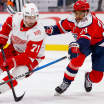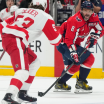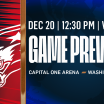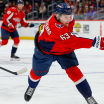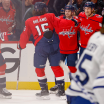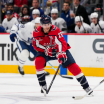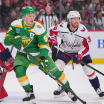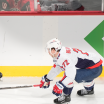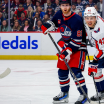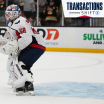It wasn't until after the last of the 217 prospects' names had been called from the draft floor in Vancouver this past weekend that we learned the salary cap for the 2019-20 NHL season will be $81.5 million. That upper limit figure represents a modest $2 million increase from last season, and it came in short of the league's midseason projection of $83 million.
Caps Deal with Cap Squeeze
It won't be easy, but the Caps may be able to fit new contracts for Andre Burakovsky and Jakub Vrana within a tighter than expected '19-20 salary cap
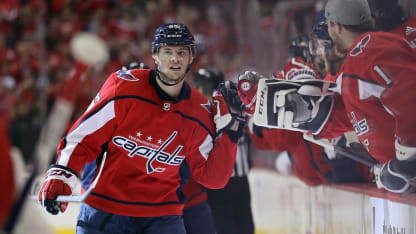
By
Mike Vogel
WashingtonCaps.com
The difference in the actual cap versus the projected cap is not significant to most teams, but the Capitals are a team that has routinely bumped against the upper limit figure for the better part of the last decade. That $1.5 million under projection is painful in Washington, so much so that some worried Twitter denizens expressed doubt that the Caps would issue a qualifying offer to Andre Burakovsky, whose qualifying figure comes in at $3.25 million for '19-20. Others believe there is no way to squeeze Burakovsky onto the Washington roster in light of the lower than expected cap threshold
The thing is, you have to qualify him. Not doing so would be squandering a useful asset. And it will be tight - isn't it always? - but we believe it's possible to fit Burakovsky onto the roster for the upcoming campaign without much of a stretch.
Not issuing a qualifying offer to Burakovsky would make him an instant unrestricted free agent at the age of 24, and might even end up earning him more than his $3.25 million qualifying offer. Washington's prospect cupboards aren't exactly replete with skilled scoring wingers waiting to play two or three NHL seasons on entry level contracts while ascending organically into the team's top six; there is no one from AHL Hershey who can naturally ascend to the roster spot left vacant if the Caps were to let Burakovsky become a UFA.
It's also worth pointing out that teams are permitted to exceed the upper threshold of the salary cap by as much as 10 percent during the offseason, so the Caps or any other team could pile up players to the tune of $90 million or so during the offseason. Teams need to be in compliance with the cap on the day when they submit their season-opening rosters, which is still some three months off on the horizon.
Last season, defenseman Brooks Orpik, winger Jakub Vrana and defenseman Jonas Siegenthaler combined to earn performance bonuses totaling $1.15 million, and those bonus overages are charged to the following season's cap figure. Right away, that takes Washington's cap figure for the 2019-20 season down to $80.35 million.
According to CapFriendly.com, the Caps have about $9.25 million to spend before reaching the ceiling. With that cap space, they'll need to come to terms with RFA forwards Burakovsky, Vrana and Chandler Stephenson, as well as RFA defenseman Christian Djoos. They'll also need to add a 13th forward, most likely one who is priced at or near the league minimum of $700,000.
The qualifying offers for Djoos ($715,000) and Stephenson ($715,000) are reasonable, and it's even possible that both players accept those figures. Both have arbitration rights, and it's also possible that one or both could come in slightly north of his qualifying figure through negotiation or arbitration. It's also possible that Washington could opt to go with a player with a lower cap hit such as Tyler Lewington ($675,000) instead of Djoos, or Shane Gersich ($700,000) instead of Stephenson for its opening night roster, thereby saving a few thousand more. If both Djoos and Stephenson accept their qualifying offers and are on the roster, the Caps are down to roughly $7.82 million. This is where it gets interesting.
It's possible and reasonable that Burakovsky signs his qualifier, too. Last season was his fifth in the NHL, and his .33 points per game rate and his 48.5% Corsi figure for '18-19 are both the lowest of his career. Some would say Burakovsky is overpaid at his qualifying figure. That may be the case, but it's not much of an overpayment, and he has the raw talent and ability to vastly exceed the value of his contract with a big season. In 328 career games, which equates to exactly four full seasons, Burakovsky has averaged 15 goals and 36 points per 82 games, which is actually reasonable production for his career average of 12:45 in nightly ice time, with minimal power play time. Don't forget, the average NHL salary for a team that spends to the cap - assuming a 22-player roster - is now $3.7 million (the league average is actually $3.2 million from last season, because not all teams spend to the cap). So Burakovsky's qualifier is about half a million bucks shy of that.
For argument's sake, let's assume that Burakovsky also signs his qualifier, leaving the Caps with approximately $4.57 million.
Washington will need a 13th (spare) forward, and one of those can be picked up at the dollar store come next week when free agency starts in the NHL on July 1. Several players were non-tendered by their teams on Tuesday, and Washington may have interest in one of those or in another free agent player who is available for the league minimum of $700,000.
Now we are down to $3.87 million, with only Vrana left to sign. He is coming off his best season in the NHL, with 24 goals and 47 points in the final season of his entry-level deal. I've seen numbers in the $4-5 million range tossed around as possibilities for Vrana, but I don't believe he has to come in quite as high as that when it's all said and done.
Coming out of his entry level deal, Vrana has 40 goals and 80 points, and is plus-24 in 176 NHL games, while averaging 13:03 per night in ice time. Vrana does not have arbitration rights, so he and his agent will need to come to terms with the Capitals without use of that tool. So how do we determine what would be a fair price tag for Vrana?
Two years ago at this time, the Caps came to terms with Burakovsky in a similar situation as he was coming out of his own entry level deal, and he signed a two-year bridge deal worth $6 million, an annual salary cap hit of $3 million. And as it happens, the career numbers of both players to that point in their respective careers are eerily similar. The main differences between the two are age and career arc. Burakovsky was a year younger at the time than Vrana is now, and Burakovsky's best year was his second season of his three-year deal while Vrana's best is the season he is coming off of now, his third. But Vrana also failed to register a point in seven playoff games last spring, while Burakovsky had the benefit of going to the bargaining table with three goals and six points in 13 playoff games in his most recent playoff test, ahead of signing his last contract.
Burakovsky had 38 goals and 95 points and was plus-29 in 196 games while averaging 13:04 per night with slightly better possession rates than Vrana. Based on that comparison and Vrana's lack of arbitration rights, it seems reasonable that the Caps could get a deal done with Vrana in the $3.25 to $3.5 million range, accounting for some inflation and salary cap increase of just under 9 percent in the two years since Burakovsky signed on the line which is dotted. Burakovsky's deal didn't take long to get done either; he signed on July 4, 2017. If the Caps can get Vrana signed in that ballpark and get the others inked for their qualifying figures, Washington could enter the season with somewhere in the neighborhood of half a million dollars worth of salary cap breathing room.
Sure, the Caps might want to get Vrana signed for a longer term, which would require an uptick in average annual value, which in turn might necessitate a Burakovsky trade. The salary cap could climb by a higher dollar amount in a couple of years when a new television deal is in place, and that might permit a longer term deal for Vrana at that point, following a bridge deal and assuming he continues his upward trajectory. But the pieces are starting to fall away from the team that hoisted the Stanley Cup less than 13 months ago. Jay Beagle, Philipp Grubauer and Alex Chiasson departed last summer. Matt Niskanen and Brooks Orpik have left the fold this summer. And it's difficult to envision a scenario in which Brett Connolly and Devante Smith-Pelly return to the District next season. Core players Alex Ovechkin and Nicklas Backstrom are approaching their mid-30s, and Backstrom and goaltender Braden Holtby are slated to become UFAs at this time next year. Washington's time to win is now.
Third-line and bottom six production is critical in the modern NHL, and in Burakovsky the Caps have a young, speedy and talented winger who is capable of scoring 20 and perhaps even 30 goals in a season. It's certainly within the realm of possibility that the Caps trade Burakovsky this summer, but it didn't happen at the trade deadline and it didn't happen at the draft. His value hasn't been lower than it is right now, but he is not a lost cause by any means. If the Caps do trade him, it's imperative that they come away with a player of similar ability, or enough cap space with which to sign/acquire one.
At 24, Burakovsky's prime years are still ahead of him. He played his best hockey down the stretch last season, with excellent underlying numbers and offensive production that was more than commensurate with the ice time he was getting during the final quarter of the campaign, which was less than 11 minutes per night. If they don't find a deal they love for him this summer, it makes sense to hold onto him and hope that he can ratchet up his value early in the season. The Caps have been adept at buying low on players such as Connolly, Smith-Pelly and others in recent years. Having the patience not to sell low on Burakovsky now could pay handsomely in the months ahead.


